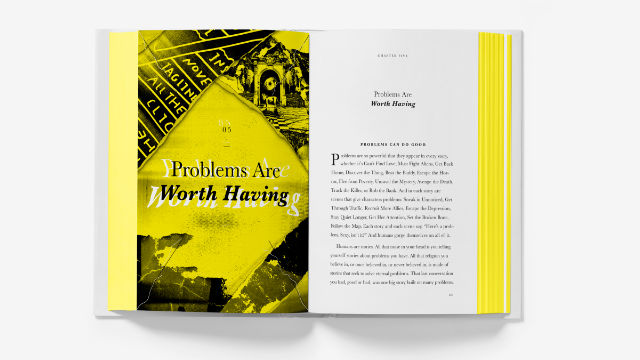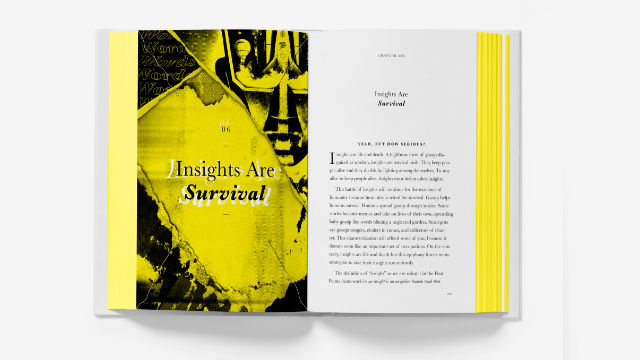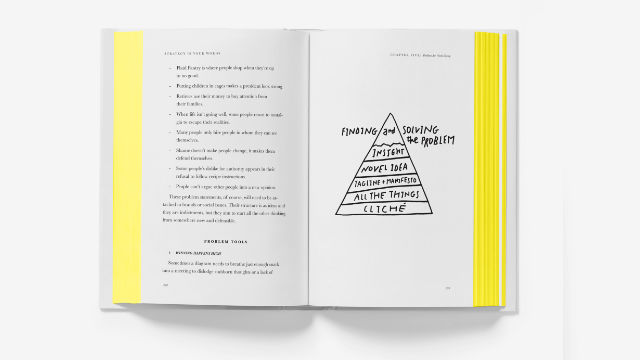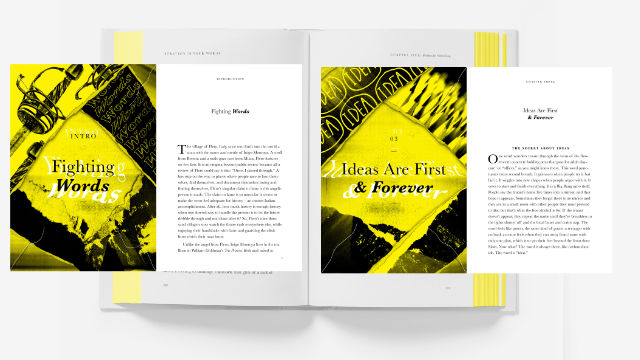Here’s the introduction to my first book Strategy Is Your Words - A Strategist’s Fight For Meaning. The first edition of the book will be 400 pages, 80,000 words, hardcover, and, [after a successful Kickstarter] should be available in July 2020 (http://bit.ly/strategykickstarter).
Please tell your friends.
Also, you can listen to this on the Sweathead podcast.

Introduction: Fighting Words
The village of Flero, Italy, once sent forth into the world a man with the mane and mettle of Inigo Montoya. A stroll from Brescia and a male gaze east from Milan, Flero features on few lists. It is an enigma beyond public review because all a review of Flero could say is this: “Once, I passed through.” A bus stop on the way to places where people race to lose themselves, find themselves, and document themselves losing and finding themselves, Flero’s singular claim to fame is this angelic person it made. The claim to fame is so muscular it seems to make the town feel adequate for history – an utmost Italian accomplishment. After all, how much history is enough history when one shrewd way to handle the present is to let the future dribble through and not chase after it? So, Flero’s nine thousand villagers now watch the future rush everywhere else, while enjoying their handshake with fame and guarding the elixir from which their man burst.
Unlike the angel from Flero, Inigo Montoya lives in fiction. Born in William Goldman’s The Princess Bride and raised in Florin, Montoya is a swordsman whose broken heart beats to avenge his father’s death. He is a human rainbow with the hair of a stallion battling the world between storms of drunkenness. But this rainbow beams only when he feels close to revenge, because revenge is how he knows himself.
Montoya’s violence dances the tango. His catchphrases are the high notes of a sommelier tasting wine from ancient space grapes. His single-mindedness ravishes the loins of the soul. In The Princess Bride, Inigo Montoya is the mourning spirit inside everyone, yet he perseveres.
And what Inigo Montoya can do with his hands and a rapier, the man from Flero could do with his feet and a ball. The name of the man from Flero is Andrea Pirlo.

Andrea Pirlo sports a pristine carpet of beard. All beard hairs know where to stand at all times. Their rectitude is the definition of “kempt” for they are bonsai and kempt bonsai is the only bonsai. Hair the color of wet sand frames Pirlo’s face. Its wisps lash and dart with every tack, turn, and twist. His sun-leathered skin is a souvenir from a lifetime in football’s riskiest arenas.
Football, not fencing, is Andrea Pirlo’s romance. He makes love with a football as Inigo Montoya makes love with a sword thrust to the heart. To marvel at Andrea Pirlo’s passes is to watch comets and stars shoot through the night sky. If a pass streaks overhead, lovers touch lips to seal their fates. Andrea Pirlo’s romance with football is a whole-body romance. But his feet make it happen. His feet can get balls places, and this skill takes him places.
From Brescia to AC Milan and Juventus, from the Olympics to the FIFA World Cup, from Italy’s Serie A to the UEFA Champions League, Andrea Pirlo’s ability to get the ball where it didn’t know it needed to go took him where he didn’t know he needed to go. After a long career in the powerhouse clubs of Italy, it took him to the fledgling football fiefdom of the United States.
On July 26, 2015, at the age of 36, Andrea Pirlo’s aging feet raced him from the rich emerald grass of Europe to the temporary turf of a South Bronx baseball stadium. This move would have surprised the young Andrea Pirlo, because New York City Football Club didn’t exist until 2015, Yankee Stadium isn’t big enough for a full-sized soccer field, and one year earlier Pirlo was still able to place as the seventh-best football player in Europe. The UEFA Men’s Player of the Year Awards were a long haul flight from the Bronx, but the Bronx is part-Italian, so perhaps it wasn’t too far from home–just far away enough for a gradual retirement. After all, Pirlo’s feet were always up to something.
And then it happened. The man Flero’s pride propelled into the world, who bore the nicknames “the architect,” “the professor,” “maestro,” and “Mozart,” spoke for strategy by speaking about football. And he spoke about football by speaking about football in his new and temporary abode, the United States of America, during his brief fling with Major League Soccer.
“It’s a very hard league to play in. It’s very physical, there’s a lot of running. So there is a lot of physical work and to me, in my mind, too little play,” Pirlo said.
Yes, Andrea Pirlo turned 37 the week he said this, in the spring of 2016, but he wasn’t airing an old athlete’s chagrin. Listen again: “A lot of running … too little play.” This is wisdom from the mystical bowels of Flero. And if you draw your ear close to the words—yes, closer still—you can hear the deathbed snake rattle of a strategist.
A lot of running; too little play.

Andrea Pirlo knew how to get a football where it didn’t know it needed to go. This meant some of his teammates didn’t know where they needed to go to greet the footballs that didn’t know where they were going. *Andrea Pirlo’s game was to make the football do the work; the American game was to make the player do the work. *
American players grow up in a culture that prizes running. The USA knows who can run. It knows who can’t run and it watches to see who runs. If a player doesn’t run, the player doesn’t last. This is a survival reflex born from the dregs of the Puritan work ethic, where work lifts believers closer to God. And in a vast and bountiful country from which many have thought they could take what they could find if they could just run there first—a belief that saw the trampling of the continent’s native peoples and environment—running still has its uses.
Running helps us catch airplanes from the broken maze of LaGuardia Airport, keep up with Maryland crab races, flee bad first dates with white-collar fishermen in Seattle, sightsee Nashville’s hot chicken in an hour, beat Los Angeles freeway traffic, gallop around Central Park in New York so we can tell the Internet later, chase venture capital funding in San Francisco while avoiding 3:00 a.m. trouble in the Tenderloin, make dramatic entrances into Miami surf eventhough it doesn’t really surf there, dodge drunken traffic late at night in Austin, grab Black Friday discounts from a Minneapolis shopping mall without strangers treading on us, release endorphins during a stint of celibacy in rural Oregon, and enter Heaven before everyone else. Running is so American, it made the USA. In return, the USA made jogging.
These evolved uses of running are light years away from its original uses: to flee predators and to eat. Indeed, running to eat might have made us look the way we look. We used to chase animals until they collapsed. With extreme fear, stress, or exhaustion, our prey would experience “capture myopathy.” Their muscles would just stop. We’d run and run and run until the animals froze. Then we’d eat the animals, unless we were vegan. All the chasing led to humans with running legs that could last for long distances. This was before farming, refined sugar, couches, traffic, office desks, and home delivery. It was also before football.
The differences between a football and an animal abound. Footballs do not have legs, brains, eyes, ears, voices, wings, arms, instincts, adrenaline, or meat. Footballs are inanimate objects. We do not need to chase footballs until they collapse. We don’t eat footballs, even though some footballs are vegan.
But chase-to-collapse is how some people play football and how many people play business. Running is the most important activity. Having others see one run is the second most important. And, if you think about it, all this running represents the gears of capitalism: people inventing needs for others to chase. “Look, here’s a ball. Go fetch. Yes, bring it back to me and I’ll throw it somewhere else and you’ll go fetch it for me, won’t you? Of course, you will. Good dog.” The US is a world leader at this. It’s also a world leader at exporting this mindset. And so the world started running because running made the USA.
A lot of running; too little play.

Running is everywhere. When people think they have never attended so many meetings, received so many emails, and watched so much Tetris on organizational charts while having so little work to show, that is running. When weekly check-ins, annual reviews, and an urban sprawl of job titles do not arrive at better work, that is running. When vague marketing briefs produce vague workshops with too many people in them who are vague about why they are there, but each has to act like the boss of the room, that is running. When timesheets are a career’s oxygen, profit-and-loss statements are kingdoms, and salary freezes last an ice age, that is running. When people discuss meeting agendas, meeting minutes, and email chains more than good work, that is running. When a strategy deck is one hundred slides long, ideas need twenty-five reviews by people who do not put pen to paper, and company decisions demand every human in the village, that is running. When management has offsites that lead to initiatives that lead nowhere, when management announces another agency repositioning in gobbledygook, and when management spends more time with itself than with its people, that is running.
Company hackathons with no follow-up, late nights patching together a pitch because the new business team sat on the marketing brief for two weeks, speaking about thinking at ad-tech conferences, senior people absent from a pitch changing the pitch the night before the pitch, whole agencies being ordered to brainstorm together but only the account team showing up, clients briefing agencies before they go on vacation, nearly all HR interactions, pitching to keep an abusive client—running running running.
Besides, are you even working if other people can’t see you working?
Jobs are now spectator sports. That’s why thinking must happen in public. That’s why we are suspicious of introverts and their inner lives. That’s why we need everybody together at all times even if somebody tries to take a day off.
But some running is better in the head. This running is called “strategy.” Because if everyone is running, who’s thinking? And what game is this? And isn’t there another game we can play?
To play a game, you need a goal, rewards, rules, an opponent, somewhere to play, and something with which to play. Inigo Montoya knows his game. He is the only person playing it. His goal is to avenge his father’s death. Revenge is his reward. His rules are a swordsman’s honor. The man who killed his father and scarred his face, Count Rugen, is his opponent. A sword fight is the place, and a sword his play object. Andrea Pirlo knew his game, too. His goal was to win football matches. Fame and riches were his spoils. His rules were the rules of an international football association. A football field was the place, and a football his object.
As much as their manes mark them similar, one flaw distinguishes Inigo Montoya from Andrea Pirlo. This flaw is a lack of strategy.
In The Princess Bride, Inigo Montoya knows what game he wants to play, but Inigo Montoya does not have a strategy. Unable to play his game for many years because he was unable to find Count Rugen, Inigo Montoya drinks himself into stupors. His stupors are his soul laughing at his lack of strategy. His stupors are his soul yelling at his brain to find new meaning. And his tale lays bare the perils of a life that commits to a single event of meaning before it ends. The soul knows irony when it sees it.
Andrea Pirlo had a strategy: to make the football surprise opponents. His tactics were to play in deep positions just in front of his center backs, to keep the ball moving pass after pass, to dispatch the football in stunning ways to his teammates, to drill it at the goal from further out than expected, and to wear his Italian locks and bonsai beard throughout. These tactics broke conventions—certainly in the US, and often in Europe as well—because the conventions were based on athleticism. The conventions were to run, dribble, blast, yell, and muscle your way to the goal. The conventions didn’t include finesse, calmness, and moving the ball in rare ways. For his entire career, Andrea Pirlo’s strategy dismantled opponents because his strategy understood the conventions within which his opponents and teammates operated. Where Inigo Montoya had flailed without a strategy, Andrea Pirlo had vanquished with a strategy. But strategy doesn’t happen in isolation and, in New York, Pirlo’s waning legs knew they were running on foreign ground.
“What I’m talking about is actually a system or culture. I don’t mean that the level of technical skills are low. I just mean there is a cultural void that needs to be filled,” Andrea Pirlo explained during the same interview in which he lamented the lack of play in US football. To acknowledge this void was for Pirlo to see his strategy without a home. New York is full of surprises for people who’ve succeeded elsewhere.
A lot of running; too little play.

When Andrea Pirlo diagnosed football in America, he also diagnosed the field of advertising and strategy. He could easily have been describing agencies, clients, and colleagues running around a football field. And among them is one strategist, hoping to Andrea Pirlo a winning strategy to the rest, but nobody knows how to receive it and people are too busy running to receive the ball anyway. And this assumes the strategist is capable of creating a strategy at all.
A culture is a set of behaviors born from a set of beliefs. Running for no reason comes from a belief that conspicuous activity makes your career happen. Conspicuous activity is a yellow Ferrari roaring in slow-moving traffic down the New Jersey turnpike . It’s unnecessary activity that others can see. At first, it’s confusing in the way that the husky heavy-metal men of Oslo’s late-night bars resemble runway models more than broken spirits. But then it catches on. Timesheets measure it and job titles reward it.
Thinking is an inconspicuous activity. It happens in the privacy of the mind. This makes it hard to watch. It’s one reason meetings exist–to weed out thinking. But, here’s the trick: like businesses, meetings are not democracies. Just watch how your next meeting discusses what’s normal to the group, how it attempts to reinforce hierarchy, and how it talks over any out-there thinking. Come for the ideas but stay for the mind control.
This game confuses many migrant office workers who believe they have landed in a country fond of the individual, freedom, and democracy. All this talk about how important you are and how teamwork makes dreams work flies in the face of research. Research shows decisions happen top-down in American businesses, and this is despite the number of meetings businesses have (more than ever) and the length of time they take to reach decisions (longer than ever). We believe in your opinion as long as you keep it to yourself.
If you work in a creative company, this game is even more bewildering. You plug your rebel self into an organizational chart where your job is ideas but only if someone more senior than you doesn’t have ideas and then your ideas might end up as their ideas. You must share your thinking as it happens while never knowing what someone more senior than you is really thinking–if they are thinking. Your thoughts must rush into words in front of other people otherwise people won’t know you’re working. You see others who excel at this climbing the ladder above you. You think, “Work out loud. It’s safer that way.” But is the work any good? And have you forgotten what you believe in?
Beautiful creative companies build themselves on behaviors that serve the creative mind—all of the creative mind. That includes the creative mind’s strengths and weaknesses, its need for quiet and for stimulation, its need for validation and its struggle to accept it, its need to create for the sake of creating and for this act to happen daily, its need for space to explore meaning, and its constant attempts to find a place in the world. A creative company does this because it believes creativity gives it and its clients an edge. Creativity needs private time, and, when ready, creativity then needs public fame.
And since words are the basic unit of meaning in human communication, creative companies demand more from words. Creative minds use words to expose truth, not hide from it. Creative minds want to free their words, not constipate them. Fierce brains abound in strategy, but too many of their public words enter a corporate-business-park dystopia. That is the cultural void Andrea Pirlo saw.
With football and revenge and glorious hair, Andrea Pirlo and Inigo Montoya achieved meaning. This is more than many of us accomplish. Pirlo achieved it with a strategy that worked on one continent but not on all. Montoya achieved it in spite of his lack of strategy. This is called luck.
Meaning can fleet; focus can drift. And running because everyone is running, especially when everyone is running off cliffs and bridges, with scissors and bayonets, with maps stuck to their faces—well, what is this?
It’s not play. Play is majestic. Play knows the heart of the game. Play knows itself. Play is unafraid to create new rules, to challenge new opponents, or to adapt itself because of new challenges. Play is you, a strategist, returning to your principal object with a light heart. This object is words.
Andrea Pirlo has retired from football and now explores the meaning of the second half of his life. This is a spiritual exercise for most humans, in which we must reckon with ourselves before reckoning with death. Meanwhile, Inigo Montoya has reckoned so much with death in his lifelong quest that he will have to reckon with life—and whether he can find a strategy to stave off the drunken stupors—after avenging his father.
In the film version of The Princess Bride, Inigo Montoya stumbles into his revenge after stumbling into Wesley’s mission to free Buttercup from the terror of Prince Humperdick. His final scuffle with Count Rugen starts with a dagger piercing his stomach as he flies into the banquet room of Humperdick’s castle.
Montoya sinks against the wall and bumps to the ground, pulling the blade from his guts. Count Rugen mocks him and prepares for his victory. But Inigo Montoya finds muscles in his elbow and parries the Count’s mustached thrusts. Once. Twice. Two more times. He gathers himself and pushes off the wall, his dreams faltering in his blood-drenched vest and shirt, and he stalks the retreating Count Rugen with a new, eerie resolve.
“Hello. My name is Inigo Montoya. You killed my father. Prepare to die.”
Montoya says this three more times between swordthrusts. He corners Count Rugen and tells him to offer him everything he asks for. The six-fingered man says, “Anything you want. I’ll make you associate senior strategy director or executive junior head of planning. I’ll give you a five-thousand-dollar bonus. I’ll give you phantom equity so you think you own the company but you’ll never own the company. I’ll let you work all the hours in the world. I’ll give you a corner office, though not mine. I’ll send you to Cannes. Do you want a summer intern? How about extra legroom for your swords? You can fly to meetings in business class from now on.” Then he sneak attacks. But Inigo Montoya catches his arm. And as Montoya slashes a fatal stab into Rugen, he whispers, “I want my craft back, you son of a bitch.”
Enough running. It’s time to play.
** Excerpt from Strategy Is Your Words - A Strategist’s Fight For Meaning. Sign up for the newsletter for updates.


